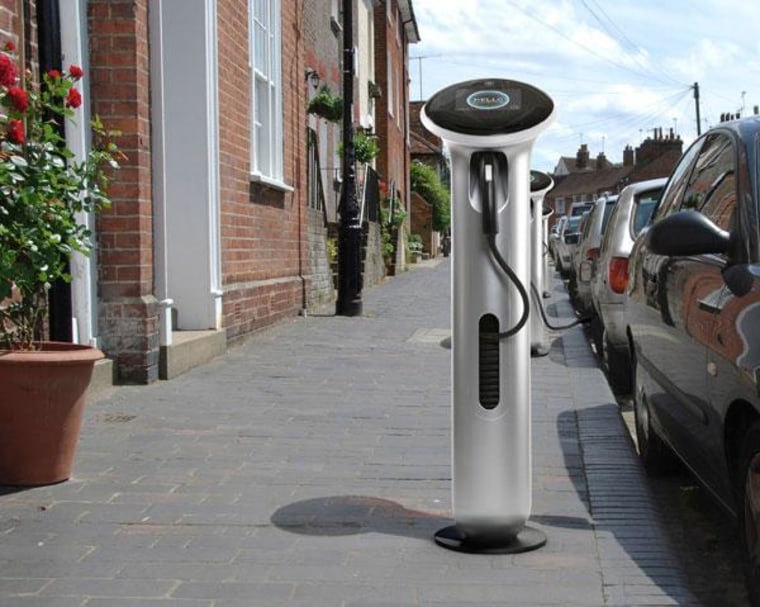This fall, the first mass-market electric vehicles (EV) for personal transportation will hit America’s highways and byways. This fleet of pure electric (think Nissan Leaf) and not-so-pure (think electric-powered Chevrolet Volt with its range-extender gas engine) vehicles is just the beginning of a hard-charging onslaught on the way we get around for work and play.
But before this zero-emissions future comes to pass, a lot has to happen. One major issue that remains to be solved is charging.
Pure-electric cars have a limited range. In the case of the Leaf, about 100 miles when fully charged. Swapping batteries right now isn’t an option, and available charging methods are a slow business indeed.
With Level 1 charging, which uses regular household 120-volt current, it takes about eight to 14 hours. Level 2 charging, using a purpose-built, 220-volt EV charging station, can cut the charge time in half. But even if that were a feasible way to go, you may have noticed that the highways aren’t yet chock-a-block with electric filing stations.
EV charging at home is seen as being the backbone of a national EV ecosystem. But home charging is not going to get most drivers across the country or even out of state, in most cases.
“The majority of charging will be at home,” said Kristen Helsel, vice president for EV solutions at AeroVironment (AV), one of a number of companies that produces EV chargers and charging stations for home and commercial use. “The availability of quick charge, though, is critically important.”
Quick charge, also known as ultra-fast charge, uses 480-volt direct current similar to the power you might find going directly into a shopping mall where it’s then stepped down or reduced in voltage and converted to alternating current. Ultra-fast chargers will make travel over longer distances technically — and psychologically — doable by reducing charging time from hours to a matter of minutes.
How long is that going to take for ultra-fast chargers to become ubiquitous and how is it going to happen?
Quick charge
The quick chargers are already here, made by companies such as Aervironment and General Electric. The missing piece of the puzzle is the establishment of standards for charging, like the Society of Automotive Engineers (SAE) J1772 standard for Level 2 electric vehicle chargers and receptacles. For EVs to flourish, it is essential that all chargers work with all vehicles.
There’s a Level 3 standard adopted from Japan, CHAdeMO, which appears to be headed toward becoming the de facto standard in the U.S., although nothing has been finalized by SAE.
But those standards should be approved by the middle of next year, said Paul Singer, general manager of GE Industrial Solutions, which produces residential and commercial chargers. Safety will be a primary consideration in setting them; 480-volt power is serious juice that can electrocute you if you’re not careful.
National EV infrastructure
The establishment of those standards will pave the way for building out a national EV infrastructure, industry experts believe.
“Five years from now, you could go coast to coast,” said AV’s Helsel. “The whole success of EVs requires a dependable infrastructure. Car manufacturers are pretty invested in making sure that infrastructure is available and successful.”
At the heart of that infrastructure will be a network of ultra-fast chargers to supplement home charging and facilitate long-distance travel. These will be commercial, attended outlets, similar to gas stations today.
Initially, GE’s Singer said, they will be clustered in densely populated areas where range is not a consideration. Next they will spread along major travel arteries like the interstate highway system.
“You’ll first see them in places like rest stops on highways,” said Singer, perhaps as adjuncts to existing gas stations. “These are ideal locations because they are attended and have other attractions.”
Charge while you work
There is also great interest in establishing public- charging stations in parking areas where workers can recharge their batteries during the day.
“We’re already seeing a pretty strong demand from municipalities and utilities,” Singer added.
“By the end of 2011, at least in big cities, there will be a significant number of these ultra-fast charging stations,” he said.
The automotive infrastructure isn’t the only thing that will change, Singer believes. There will be an accompanying lifestyle change to address the problem of “range anxiety,” the fear that your battery will run down when you’re nowhere near a charging station.
Instead of waiting for your battery to completely run done before recharging, you’ll start treating your car like you do you cell phone, taking frequent sips of power rather than infrequent gulps.
“You’ll be topping off as you go,” he said.
- Electric Vehicles Face Charging Challenges
- Google’s Driverless Cars Point to ‘Smart’ Vehicles of the Future
- Electric Car Therapy Could Cut U.S. Oil Addiction, Study Finds
Reach BusinessNewsDaily senior writer Ned Smith at nsmith@techmedianetwork.com . Follow him on twitter @nedbsmith .
